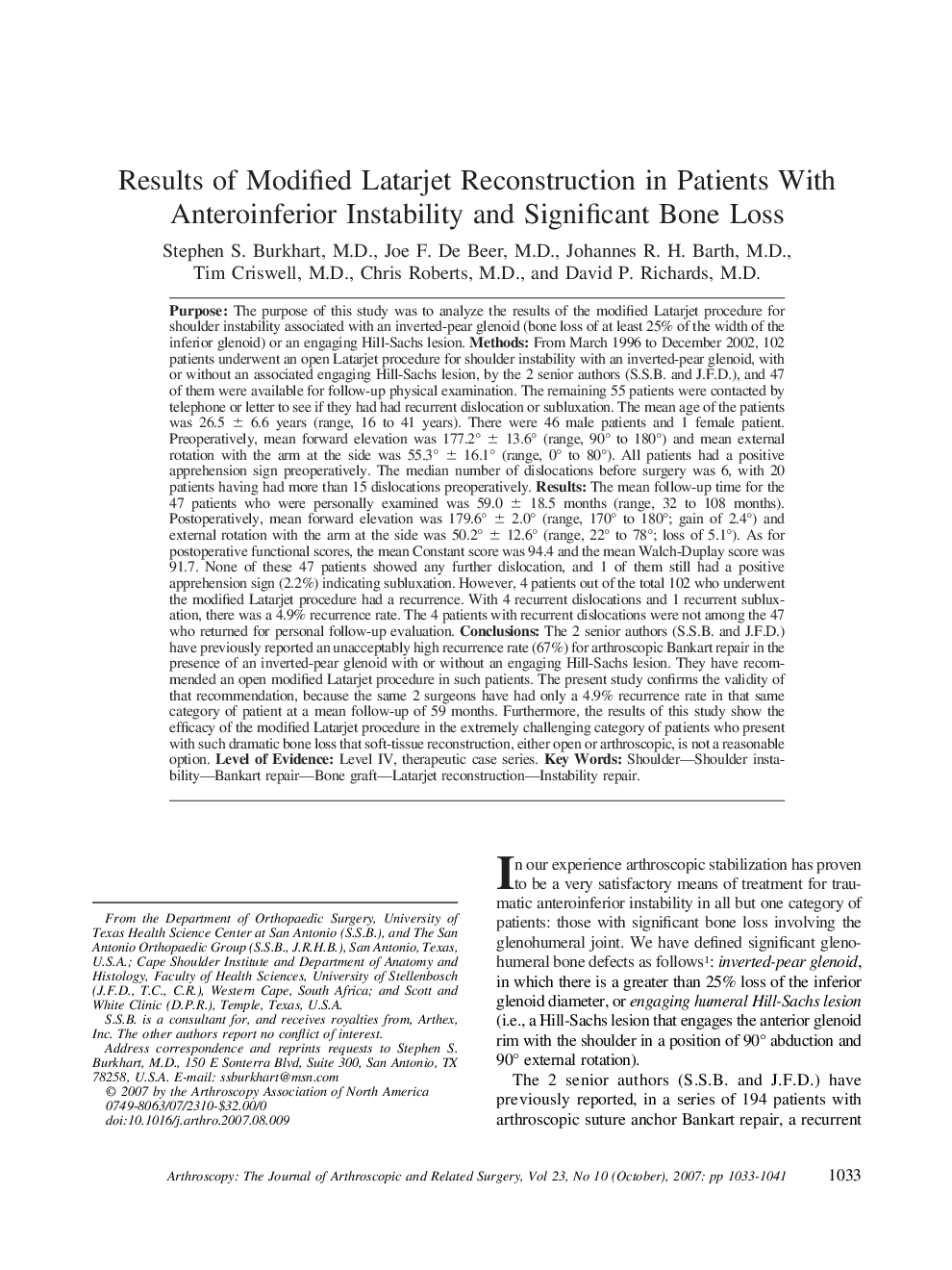| Article ID | Journal | Published Year | Pages | File Type |
|---|---|---|---|---|
| 4045566 | Arthroscopy: The Journal of Arthroscopic & Related Surgery | 2007 | 9 Pages |
Purpose: The purpose of this study was to analyze the results of the modified Latarjet procedure for shoulder instability associated with an inverted-pear glenoid (bone loss of at least 25% of the width of the inferior glenoid) or an engaging Hill-Sachs lesion. Methods: From March 1996 to December 2002, 102 patients underwent an open Latarjet procedure for shoulder instability with an inverted-pear glenoid, with or without an associated engaging Hill-Sachs lesion, by the 2 senior authors (S.S.B. and J.F.D.), and 47 of them were available for follow-up physical examination. The remaining 55 patients were contacted by telephone or letter to see if they had had recurrent dislocation or subluxation. The mean age of the patients was 26.5 ± 6.6 years (range, 16 to 41 years). There were 46 male patients and 1 female patient. Preoperatively, mean forward elevation was 177.2° ± 13.6° (range, 90° to 180°) and mean external rotation with the arm at the side was 55.3° ± 16.1° (range, 0° to 80°). All patients had a positive apprehension sign preoperatively. The median number of dislocations before surgery was 6, with 20 patients having had more than 15 dislocations preoperatively. Results: The mean follow-up time for the 47 patients who were personally examined was 59.0 ± 18.5 months (range, 32 to 108 months). Postoperatively, mean forward elevation was 179.6° ± 2.0° (range, 170° to 180°; gain of 2.4°) and external rotation with the arm at the side was 50.2° ± 12.6° (range, 22° to 78°; loss of 5.1°). As for postoperative functional scores, the mean Constant score was 94.4 and the mean Walch-Duplay score was 91.7. None of these 47 patients showed any further dislocation, and 1 of them still had a positive apprehension sign (2.2%) indicating subluxation. However, 4 patients out of the total 102 who underwent the modified Latarjet procedure had a recurrence. With 4 recurrent dislocations and 1 recurrent subluxation, there was a 4.9% recurrence rate. The 4 patients with recurrent dislocations were not among the 47 who returned for personal follow-up evaluation. Conclusions: The 2 senior authors (S.S.B. and J.F.D.) have previously reported an unacceptably high recurrence rate (67%) for arthroscopic Bankart repair in the presence of an inverted-pear glenoid with or without an engaging Hill-Sachs lesion. They have recommended an open modified Latarjet procedure in such patients. The present study confirms the validity of that recommendation, because the same 2 surgeons have had only a 4.9% recurrence rate in that same category of patient at a mean follow-up of 59 months. Furthermore, the results of this study show the efficacy of the modified Latarjet procedure in the extremely challenging category of patients who present with such dramatic bone loss that soft-tissue reconstruction, either open or arthroscopic, is not a reasonable option. Level of Evidence: Level IV, therapeutic case series.
